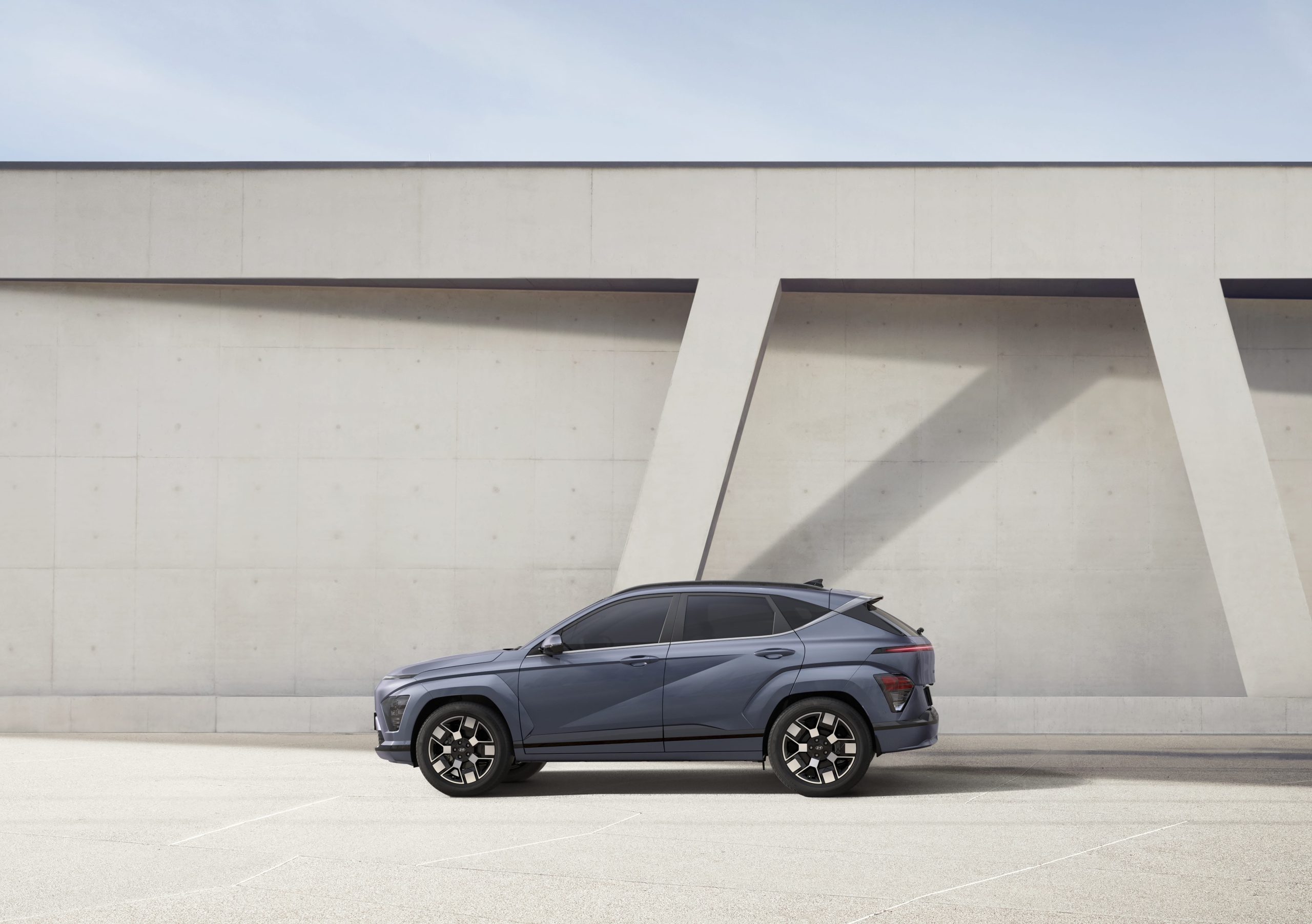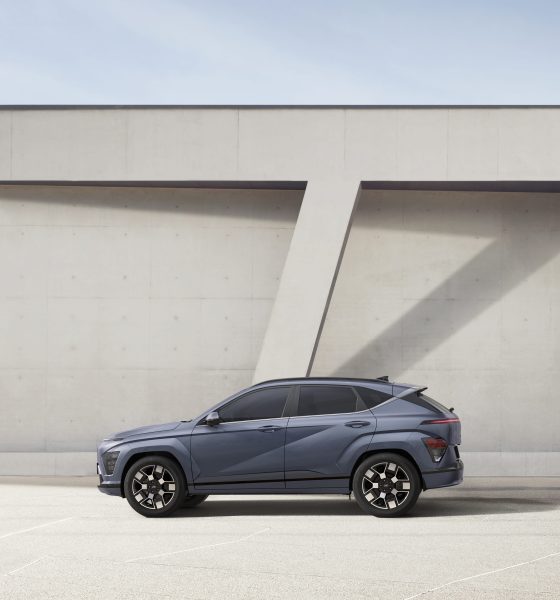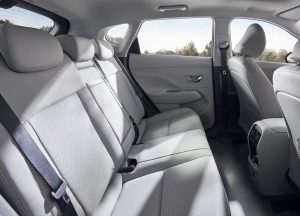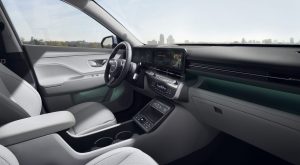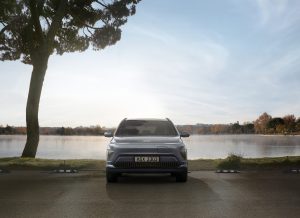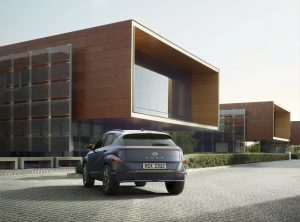Hyundai has unveiled its new second-generation Kona vehicle, including the Kona EV, hybrid, and ICE variants.
The Hyundai Kona and the Chevy Bolt have become a go-to vehicles for those looking for their first EV. The Kona’s entry-level price point and impressive specs for the money have attracted numerous buyers. It’s clear Hyundai is hoping for a similar reaction to the next-generation Kona EV it released yesterday.
The second generation of the Kona EV brings iterative technical changes and a refreshed design to the flexible platform, which still allows customers to choose from an ICE, EV, or hybrid version.
Hyundai’s new Kona EV is the star of the show, and the Korean automaker made that clear, stating that this was the first time the Kona had been designed for electrification first, with the ability to add a gas engine designed second.
The second generation Kona EV comes with a max range of 304 miles from its Long-Range 65.4kWh battery, though a smaller Standard-Range battery is also available with a capacity of 48.4kWh. Hyundai didn’t specify the range of the smaller battery, but assuming a similar efficiency as the Long-Range battery, it should have roughly 225 miles of range.
With the Long-Range battery, customers also receive a more powerful motor, providing an ample 217 horsepower and 188 pound-feet of torque to the front wheels. The Standard-Range battery has a less powerful 156 horsepower and 188 pound-feet of torque motor.
While the vehicle’s power is only bumped slightly compared to the previous generation, the added ~50 miles of max range is undoubtedly a welcome addition to the platform.
With DC fast charging, the new Hyundai Kona EV will charge from 10-80% in 41 minutes. Hyundai didn’t specify if the charging time differed between the battery options. Sadly, neither vehicle is equipped with Hyundai’s phenomenal 800-volt architecture, which means the Kona EV’s charging time is essentially unchanged from the previous generation.
The more apparent upgrades coming to the new Kona are in design. Not only does the Kona receive the same angular design found on many of Hyundai’s larger SUV offerings, but it becomes slightly larger than the previous generation. Hyundai states that this change was made to provide the maximum interior space to occupants while retaining the vehicle’s mid-size categorization.
The Korean automaker also provides the Kona EV with a laundry list of features, making it a far more useful vehicle in numerous situations. Its most sought-after feature is likely its vehicle-to-load technology, allowing customers to plug in everything from a mini-fridge to a TV. Besides that, Hyundai also includes OTA updates with the vehicle, allowing it to improve consistently throughout its ownership.
But with all these details released, Hyundai left out the most important, the Kona EV’s price.
Hyundai sadly no longer qualifies for federal EV incentives in the United States that could dramatically lower the price of the vehicle for many consumers. And with the Tesla Model 3 and Chevy Bolt cheaper than ever, both of which qualify for federal incentives, Hyundai may be in somewhat of a challenging situation.
Currently, the Hyundai Kona EV is listed for $33,550, roughly $13,000 more expensive than the Chevy Bolt with federal incentives, and only $2,000 cheaper than the base Tesla Model 3 with incentives.
Hyundai undoubtedly faces an uphill battle considering its lack of federal incentives. However, considering its success at attracting customers to its IONIQ Platform, the company still has a great shot of luring buyers nonetheless. Despite this hurdle, the automaker can hopefully still help more consumers electrify with its newest models.
What do you think of the article? Do you have any comments, questions, or concerns? Shoot me an email at william@teslarati.com. You can also reach me on Twitter @WilliamWritin. If you have news tips, email us at tips@teslarati.com!

News
Nvidia CEO Jensen Huang explains difference between Tesla FSD and Alpamayo
“Tesla’s FSD stack is completely world-class,” the Nvidia CEO said.
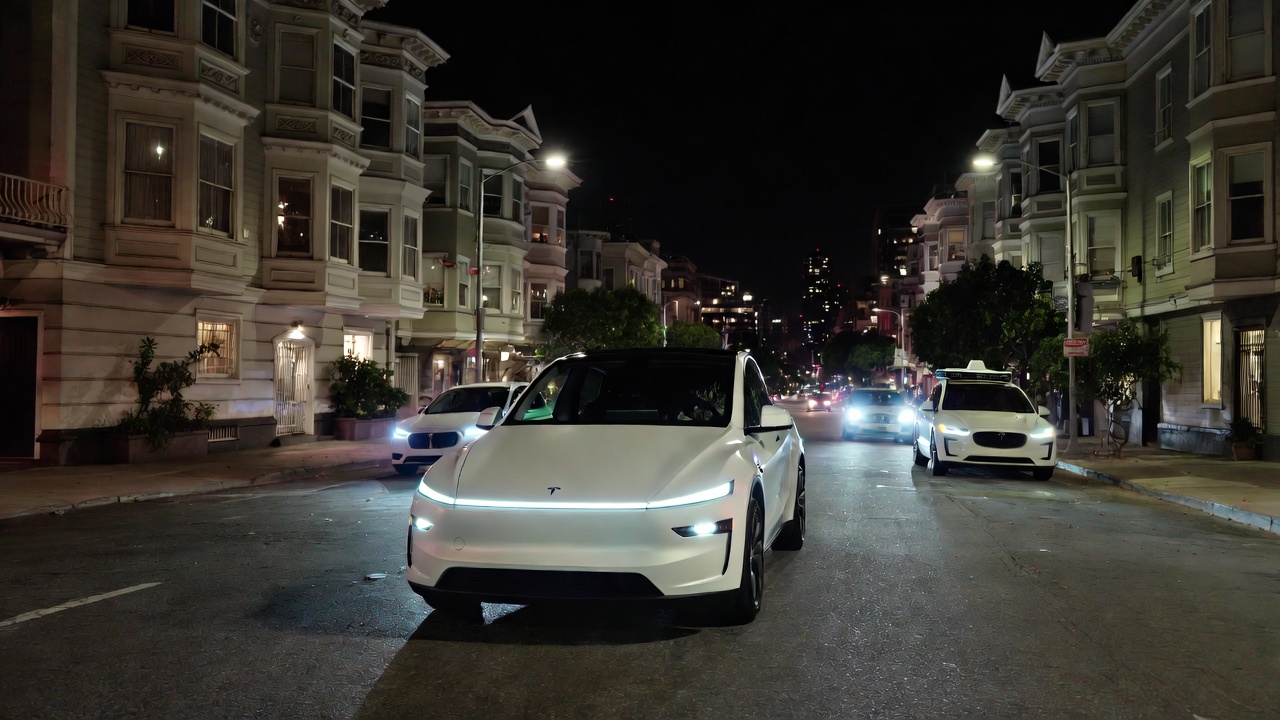
NVIDIA CEO Jensen Huang has offered high praise for Tesla’s Full Self-Driving (FSD) system during a Q&A at CES 2026, calling it “world-class” and “state-of-the-art” in design, training, and performance.
More importantly, he also shared some insights about the key differences between FSD and Nvidia’s recently announced Alpamayo system.
Jensen Huang’s praise for Tesla FSD
Nvidia made headlines at CES following its announcement of Alpamayo, which uses artificial intelligence to accelerate the development of autonomous driving solutions. Due to its focus on AI, many started speculating that Alpamayo would be a direct rival to FSD. This was somewhat addressed by Elon Musk, who predicted that “they will find that it’s easy to get to 99% and then super hard to solve the long tail of the distribution.”
During his Q&A, Nvidia CEO Jensen Huang was asked about the difference between FSD and Alpamayo. His response was extensive:
“Tesla’s FSD stack is completely world-class. They’ve been working on it for quite some time. It’s world-class not only in the number of miles it’s accumulated, but in the way it’s designed, the way they do training, data collection, curation, synthetic data generation, and all of their simulation technologies.
“Of course, the latest generation is end-to-end Full Self-Driving—meaning it’s one large model trained end to end. And so… Elon’s AD system is, in every way, 100% state-of-the-art. I’m really quite impressed by the technology. I have it, and I drive it in our house, and it works incredibly well,” the Nvidia CEO said.
Nvidia’s platform approach vs Tesla’s integration
Huang also stated that Nvidia’s Alpamayo system was built around a fundamentally different philosophy from Tesla’s. Rather than developing self-driving cars itself, Nvidia supplies the full autonomous technology stack for other companies to use.
“Nvidia doesn’t build self-driving cars. We build the full stack so others can,” Huang said, explaining that Nvidia provides separate systems for training, simulation, and in-vehicle computing, all supported by shared software.
He added that customers can adopt as much or as little of the platform as they need, noting that Nvidia works across the industry, including with Tesla on training systems and companies like Waymo, XPeng, and Nuro on vehicle computing.
“So our system is really quite pervasive because we’re a technology platform provider. That’s the primary difference. There’s no question in our mind that, of the billion cars on the road today, in another 10 years’ time, hundreds of millions of them will have great autonomous capability. This is likely one of the largest, fastest-growing technology industries over the next decade.”
He also emphasized Nvidia’s open approach, saying the company open-sources its models and helps partners train their own systems. “We’re not a self-driving car company. We’re enabling the autonomous industry,” Huang said.
Elon Musk
Elon Musk confirms xAI’s purchase of five 380 MW natural gas turbines
The deal, which was confirmed by Musk on X, highlights xAI’s effort to aggressively scale its operations.
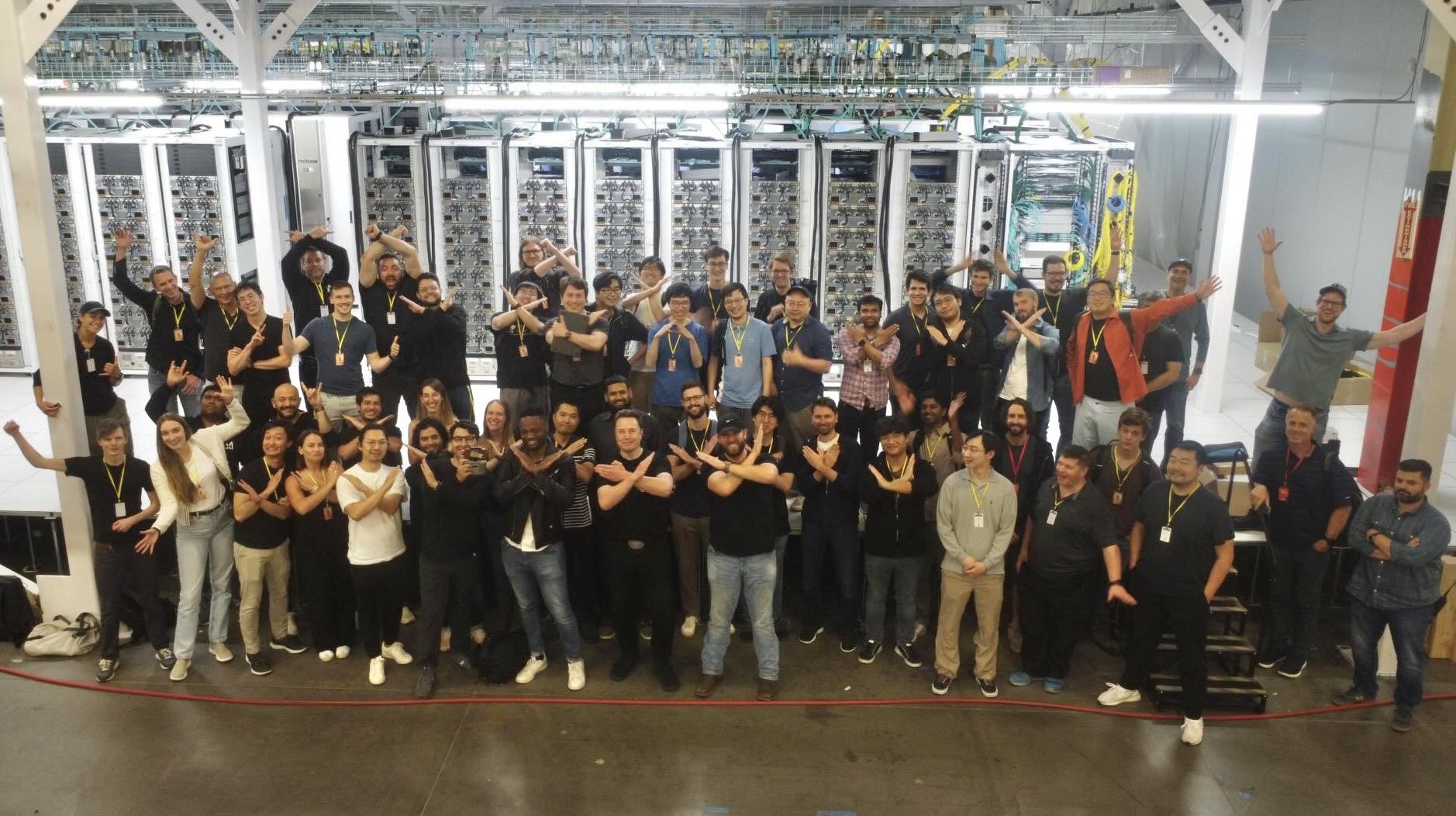
xAI, Elon Musk’s artificial intelligence startup, has purchased five additional 380 MW natural gas turbines from South Korea’s Doosan Enerbility to power its growing supercomputer clusters.
The deal, which was confirmed by Musk on X, highlights xAI’s effort to aggressively scale its operations.
xAI’s turbine deal details
News of xAI’s new turbines was shared on social media platform X, with user @SemiAnalysis_ stating that the turbines were produced by South Korea’s Doosan Enerbility. As noted in an Asian Business Daily report, Doosan Enerbility announced last October that it signed a contract to supply two 380 MW gas turbines for a major U.S. tech company. Doosan later noted in December that it secured an order for three more 380 MW gas turbines.
As per the X user, the gas turbines would power an additional 600,000+ GB200 NVL72 equivalent size cluster. This should make xAI’s facilities among the largest in the world. In a reply, Elon Musk confirmed that xAI did purchase the turbines. “True,” Musk wrote in a post on X.
xAI’s ambitions
Recent reports have indicated that xAI closed an upsized $20 billion Series E funding round, exceeding the initial $15 billion target to fuel rapid infrastructure scaling and AI product development. The funding, as per the AI startup, “will accelerate our world-leading infrastructure buildout, enable the rapid development and deployment of transformative AI products.”
The company also teased the rollout of its upcoming frontier AI model. “Looking ahead, Grok 5 is currently in training, and we are focused on launching innovative new consumer and enterprise products that harness the power of Grok, Colossus, and 𝕏 to transform how we live, work, and play,” xAI wrote in a post on its website.
Elon Musk
Elon Musk’s xAI closes upsized $20B Series E funding round
xAI announced the investment round in a post on its official website.

xAI has closed an upsized $20 billion Series E funding round, exceeding the initial $15 billion target to fuel rapid infrastructure scaling and AI product development.
xAI announced the investment round in a post on its official website.
A $20 billion Series E round
As noted by the artificial intelligence startup in its post, the Series E funding round attracted a diverse group of investors, including Valor Equity Partners, Stepstone Group, Fidelity Management & Research Company, Qatar Investment Authority, MGX, and Baron Capital Group, among others.
Strategic partners NVIDIA and Cisco Investments also continued support for building the world’s largest GPU clusters.
As xAI stated, “This financing will accelerate our world-leading infrastructure buildout, enable the rapid development and deployment of transformative AI products reaching billions of users, and fuel groundbreaking research advancing xAI’s core mission: Understanding the Universe.”
xAI’s core mission
Th Series E funding builds on xAI’s previous rounds, powering Grok advancements and massive compute expansions like the Memphis supercluster. The upsized demand reflects growing recognition of xAI’s potential in frontier AI.
xAI also highlighted several of its breakthroughs in 2025, from the buildout of Colossus I and II, which ended with over 1 million H100 GPU equivalents, and the rollout of the Grok 4 Series, Grok Voice, and Grok Imagine, among others. The company also confirmed that work is already underway to train the flagship large language model’s next iteration, Grok 5.
“Looking ahead, Grok 5 is currently in training, and we are focused on launching innovative new consumer and enterprise products that harness the power of Grok, Colossus, and 𝕏 to transform how we live, work, and play,” xAI wrote.
